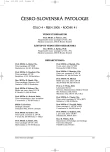Melanoma Simulating Malignant Soft Tissue Tumour
Authors:
J. Mačák; I. Zavřelová
Authors‘ workplace:
Ústav patologické anatomie FN a LF MU, Brno
Published in:
Čes.-slov. Patol., 41, 2005, No. 4, p. 146-149
Category:
Original Article
Overview
The authors presented the case of an 82-year-old man with primary nodular melanoma of the skin on the back (Breslow 3 mm) which repeatedly metastasized five times to the cervical lymph nodes. Metastases were excised. The aim of this report was to demonstrate changes in the phenotype and immunophenotype during tumour progression. Originally round and oval melanoblasts had a characteristic immunophenotype. They were S100 protein, HMB45, Malan A, MITF positive. From the second biopsy the immunophenotype began to change, and the amount of positive cells declined. In the succeeding biopsies the morphology was also changed. There were spindle cells which formed mutually intermingled bundles in places with large multinucleate cells. The histological pattern assembled malignant mesenchymal tumour - type malignant fibrous histiocytoma. The immunophenotype was also changed. The second to fifth metastases in the cervical region were only S100 protein positive. The other above-mentioned melanoma markers were negative. Differential diagnosis includes neurotropic-desmoplastic malignant melanoma, Bednář tumour (pigmented dermatofibrosarcoma protuberans; storiform neurofibroma), malignant peripheral nerve sheath tumour (neurogenic sarcoma) and malignant fibrous histiocytoma.
Key words:
melanoma – malignant fibrous histiocytoma – immunohistochemistry - phenotype
Labels
Anatomical pathology Forensic medical examiner ToxicologyArticle was published in
Czecho-Slovak Pathology

2005 Issue 4
Most read in this issue
- Autoimmune Gastritis. A Clinicopathologic Study of 25 Cases
- Melanoma Simulating Malignant Soft Tissue Tumour
- Pulmonary Veins and Atrial Fibrillation: A Pathological Study of 100 Hearts
- Gastrointestinal Stromal Tumor (GIST) with Glandular Component. A Report of an Unusual Tumor Resembling Adenosarcoma
